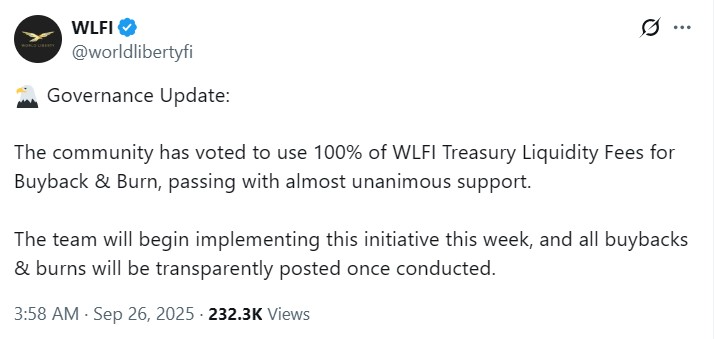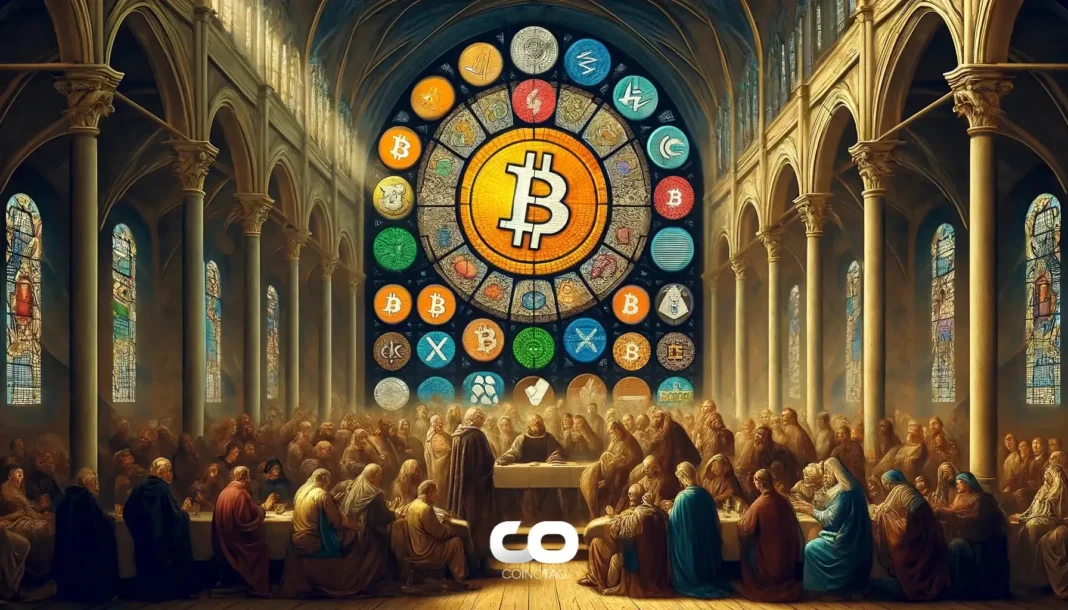World Liberty Financial will start a WLFI buyback and burn program next week to reduce circulating WLFI supply after a 41% drop in September, using fees from WLFI-controlled liquidity on Ethereum, BNB Chain and Solana to buy WLFI and send tokens to a burn address.
-
Buyback converts treasury fees into WLFI and sends tokens to a burn address.
-
Community vote approved the plan with 99% support; only WLFI-controlled liquidity fees are included.
-
WLFI fell ~41% from its Sept. 1 all-time high; current price cited as $0.19 per CoinGecko.
WLFI buyback and burn: World Liberty Financial launches a fee-funded buyback and burn after a 41% drop — learn the mechanics and what holders should watch next.
World Liberty Financial will launch a WLFI token buyback and burn next week after a 41% price drop in September, aiming to cut supply and stabilize value.
The Trump family-backed decentralized finance (DeFi) project World Liberty Financial announced a fee-funded WLFI buyback and burn program scheduled to begin next week. The protocol plans to collect fees from WLFI-controlled liquidity on Ethereum, BNB Chain and Solana, convert those fees to WLFI on open markets, then send purchased tokens to a burn address.
The team said the initiative will be publicly disclosed, with updates on each buyback and burn event. Token buybacks and burns are common mechanisms to reduce circulating supply and attempt to absorb selling pressure after sharp price declines.

What is the WLFI buyback and burn program?
The WLFI buyback and burn program is a treasury mechanism in which fees from WLFI-controlled liquidity pools are used to purchase WLFI on secondary markets and then permanently remove those tokens by sending them to a burn address. The project says the step is designed to reduce circulating supply and support price stability.
How did WLFI’s price move before the announcement?
WLFI fell roughly 41% from an all-time high of $0.33 on Sept. 1 to about $0.19 on Friday, per CoinGecko. The decline prompted the governance proposal that passed with 99% approval from holders, according to the project’s disclosure.
How will World Liberty Financial execute WLFI buybacks?
The WLFI proposal specifies that fees from WLFI-controlled liquidity positions across Ethereum, BNB Chain and Solana will be aggregated. Those funds will be swapped for WLFI on open markets and then transferred to an on-chain burn address to remove supply permanently.
The team clarified community or third-party liquidity pools are excluded; only pools controlled by WLFI’s treasury are eligible. The project also pledged to publish transaction-level updates after each buyback and burn.
Frequently Asked Questions
Is the number of tokens to be burned specified?
Details on the exact volume of WLFI to be repurchased and burned were not specified in the proposal. Some market participants have speculated about daily burn volumes (for example, a hypothetical ~4 million WLFI per day), but the proposal itself does not disclose firm figures.
What do experts and data sources say?
Public market data from CoinGecko shows the recent price decline discussed above. Independent reporting and industry commentary have framed buybacks and burns as standard supply-control tools in crypto, though effectiveness varies by tokenomics and market conditions.
How the buyback and burn will work (HowTo)
Key Takeaways
- Immediate action: WLFI will begin a buyback and burn next week using fees from WLFI-controlled liquidity.
- Governance-backed: The plan passed with 99% holder approval, but third-party liquidity is excluded.
- Unclear scale: The team has not specified exact burn volumes; market estimates vary.
Conclusion
The WLFI buyback and burn program is a governance-approved response to a ~41% September drawdown, designed to reduce circulating supply and potentially stabilize price. Watch on-chain transaction disclosures and treasury fee reports for the clearest indicators of impact. For ongoing coverage, COINOTAG will update this story as WLFI publishes buyback and burn records.
Published: 2025-09-26. Updated: 2025-09-26. Author: COINOTAG.
Data and reporting referenced: CoinGecko price data; independent industry reporting. Related reporting referenced in plain text: Judge denies Justin Sun’s bid to block Bloomberg over crypto holdings.





